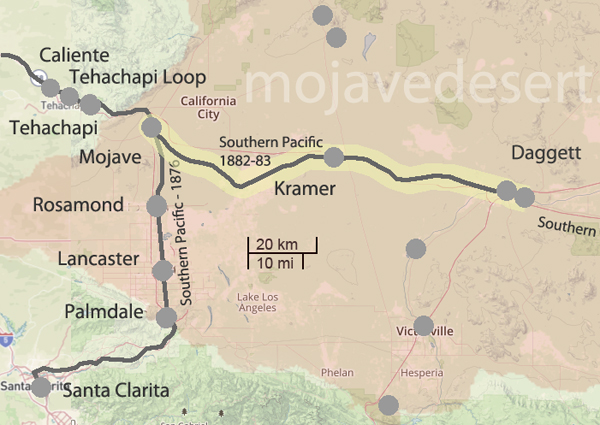Roads & Rails

THE LOGISTICS for supplying even a small camp like Calico were fairly elaborate. Two routes passed near the district: the old wagon road from San Bernardino and a Southern Pacific Railroad line being extended from Mojave Station to Needles; the line opened up Calico to the business of Los Angeles, Bakersfield, and San Francisco.
The wagon road, which was of fair quality, was lined with supply stations. Rogers, near the later site of Victorville, even supported a post office (Desert), one of the few in the Mojave. Near the future site of Barstow was Grape Vine Station, where E. J. Miller sold mining supplies and general merchandise. Fish Ponds, on the Mojave River, between the later future towns of Daggett and Barstow, was frankly a delight. The river bottom was covered with cottonwood and mesquite trees. Sloughs in the river were filled with small fish and wild ducks in season. Travel over the road could be heavy. Aaron Harrison was running express and passenger stages from San Bernardino twice a week in late 1882; they made the trip in a day and a half. And the King Mine would haul in all supplies, feed, and hay from San Bernardino and send out 20 tons of ore a day to a mill at Oro Grande. This immense freighting enterprise employed 17 men and 130 mules.
Considering the heavy amount of traffic, the Southern Pacific line arrived none too soon. The extension was completed past Waterman's Station by October. And an agent of the railroad began interviewing Calico's residents about the site of a proposed depot. The coming of railroad service elated Calico's citizens; they "had the honor of attending a ball" at Waterman's. The ball offered "excellent music and a fine collation. All enjoyed themselves in the mazy dance; we wish we had been there," wrote an editor of the Print. The citizens would not be disappointed: in November, trains began running to the new depot, Calico Station, on the Mojave River, about six or seven miles from the mining camp. (Calico Station would be renamed Daggett in early 1883; Waterman's became the nucleus of Barstow.)
The construction of the Southern Pacific line redirected Calico's trade for a while, away from San Bernardino. Even before the line's completion, J.M. Miller was bringing in goods for his store from San Francisco, a San Francisco dealer was offering to buy are, the James store was selling Kern River flour, and two Bakersfield businesses, including a bank, were advertising in the Print.